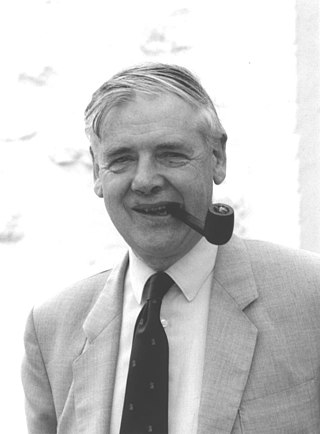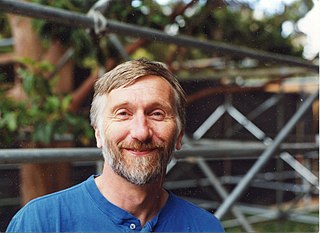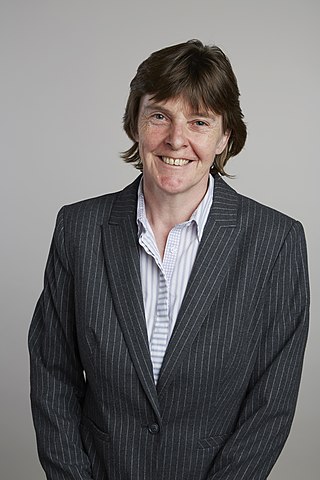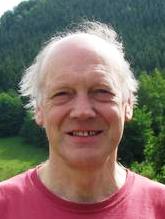
In statistical physics and mathematics, percolation theory describes the behavior of a network when nodes or links are added. This is a geometric type of phase transition, since at a critical fraction of addition the network of small, disconnected clusters merge into significantly larger connected, so-called spanning clusters. The applications of percolation theory to materials science and in many other disciplines are discussed here and in the articles Network theory and Percolation.

In physics, chemistry, and materials science, percolation refers to the movement and filtering of fluids through porous materials. It is described by Darcy's law. Broader applications have since been developed that cover connectivity of many systems modeled as lattices or graphs, analogous to connectivity of lattice components in the filtration problem that modulates capacity for percolation.

In mathematics, random graph is the general term to refer to probability distributions over graphs. Random graphs may be described simply by a probability distribution, or by a random process which generates them. The theory of random graphs lies at the intersection between graph theory and probability theory. From a mathematical perspective, random graphs are used to answer questions about the properties of typical graphs. Its practical applications are found in all areas in which complex networks need to be modeled – many random graph models are thus known, mirroring the diverse types of complex networks encountered in different areas. In a mathematical context, random graph refers almost exclusively to the Erdős–Rényi random graph model. In other contexts, any graph model may be referred to as a random graph.

Béla Bollobás FRS is a Hungarian-born British mathematician who has worked in various areas of mathematics, including functional analysis, combinatorics, graph theory, and percolation. He was strongly influenced by Paul Erdős since the age of 14.

John Michael Hammersley, was a British mathematician best known for his foundational work in the theory of self-avoiding walks and percolation theory.

Alexander Philip Dawid is Emeritus Professor of Statistics of the University of Cambridge, and a Fellow of Darwin College, Cambridge. He is a leading proponent of Bayesian statistics.

David George Kendall FRS was an English statistician and mathematician, known for his work on probability, statistical shape analysis, ley lines and queueing theory. He spent most of his academic life in the University of Oxford (1946–1962) and the University of Cambridge (1962–1985). He worked with M. S. Bartlett during World War II, and visited Princeton University after the war.
Olav Kallenberg is a probability theorist known for his work on exchangeable stochastic processes and for his graduate-level textbooks and monographs. Kallenberg is a professor of mathematics at Auburn University in Alabama in the USA.

Peter Gavin Hall was an Australian researcher in probability theory and mathematical statistics. The American Statistical Association described him as one of the most influential and prolific theoretical statisticians in the history of the field. The School of Mathematics and Statistics Building at The University of Melbourne was renamed the Peter Hall building in his honour on 9 December 2016.

David John Aldous FRS is a mathematician known for his research on probability theory and its applications, in particular in topics such as exchangeability, weak convergence, Markov chain mixing times, the continuum random tree and stochastic coalescence. He entered St. John's College, Cambridge, in 1970 and received his Ph.D. at the University of Cambridge in 1977 under his advisor, D. J. H. Garling. Aldous was on the faculty at University of California, Berkeley from 1979 until his retirement in 2018.

David Williams FRS is a Welsh mathematician who works in probability theory.

Harry Kesten was a Jewish American mathematician best known for his work in probability, most notably on random walks on groups and graphs, random matrices, branching processes, and percolation theory.
The Hammersley–Clifford theorem is a result in probability theory, mathematical statistics and statistical mechanics that gives necessary and sufficient conditions under which a strictly positive probability distribution can be represented as events generated by a Markov network. It is the fundamental theorem of random fields. It states that a probability distribution that has a strictly positive mass or density satisfies one of the Markov properties with respect to an undirected graph G if and only if it is a Gibbs random field, that is, its density can be factorized over the cliques of the graph.

Sourav Chatterjee is an Indian mathematician, specializing in mathematical statistics and probability theory. Chatterjee is credited with work on the study of fluctuations in random structures, concentration and super-concentration inequalities, Poisson and other non-normal limits, first-passage percolation, Stein's method and spin glasses. He has received a Sloan Fellowship in mathematics, Tweedie Award, Rollo Davidson Prize, Doeblin Prize, Loève Prize, and Infosys Prize in mathematical sciences. He was an invited speaker at the International Congress of Mathematicians in 2014.
Gareth Owen Roberts FRS FLSW is a statistician and applied probabilist. He is Professor of Statistics in the Department of Statistics and Director of the Centre for Research in Statistical Methodology (CRiSM) at the University of Warwick. He is an established authority on the stability of Markov chains, especially applied to Markov chain Monte Carlo (MCMC) theory methodology for a wide range of latent statistical models with applications in spatial statistics, infectious disease epidemiology and finance.
Martin Thomas Barlow FRS FRSC is a British mathematician who is professor of mathematics at the University of British Columbia in Canada since 1992.
James Anthony Dominic Welsh was an English mathematician and emeritus professor of Oxford University's Mathematical Institute. He was an expert in matroid theory, the computational complexity of combinatorial enumeration problems, percolation theory, and cryptography.
Philip Candelas, is a British physicist and mathematician. After 20 years at the University of Texas at Austin, he served as Rouse Ball Professor of Mathematics at the University of Oxford until 2020 and is a Fellow of Wadham College, Oxford.

Gordon Douglas Slade is a Canadian mathematician, specializing in probability theory.

Alison Mary Etheridge is Professor of Probability and former Head of the Department of Statistics, University of Oxford. Etheridge is a fellow of Magdalen College, Oxford.













